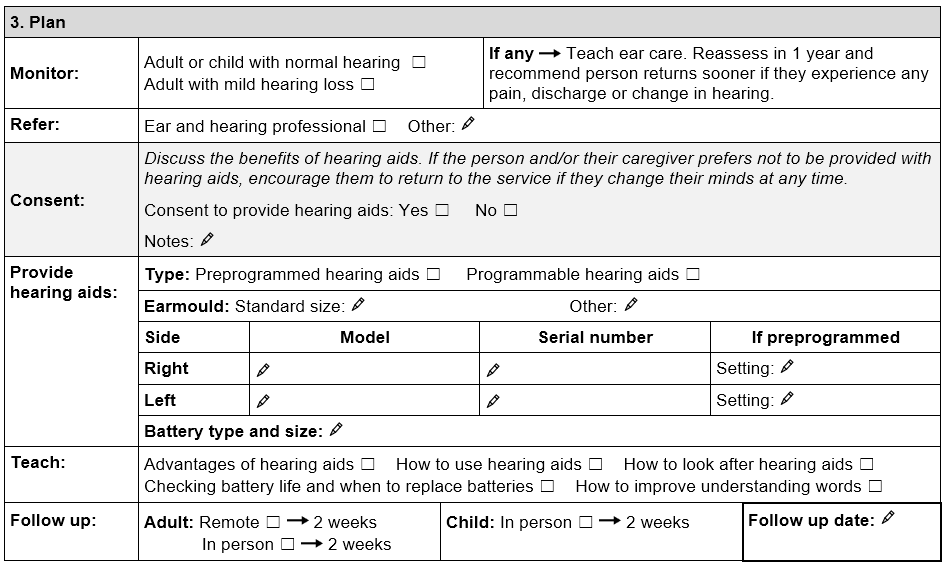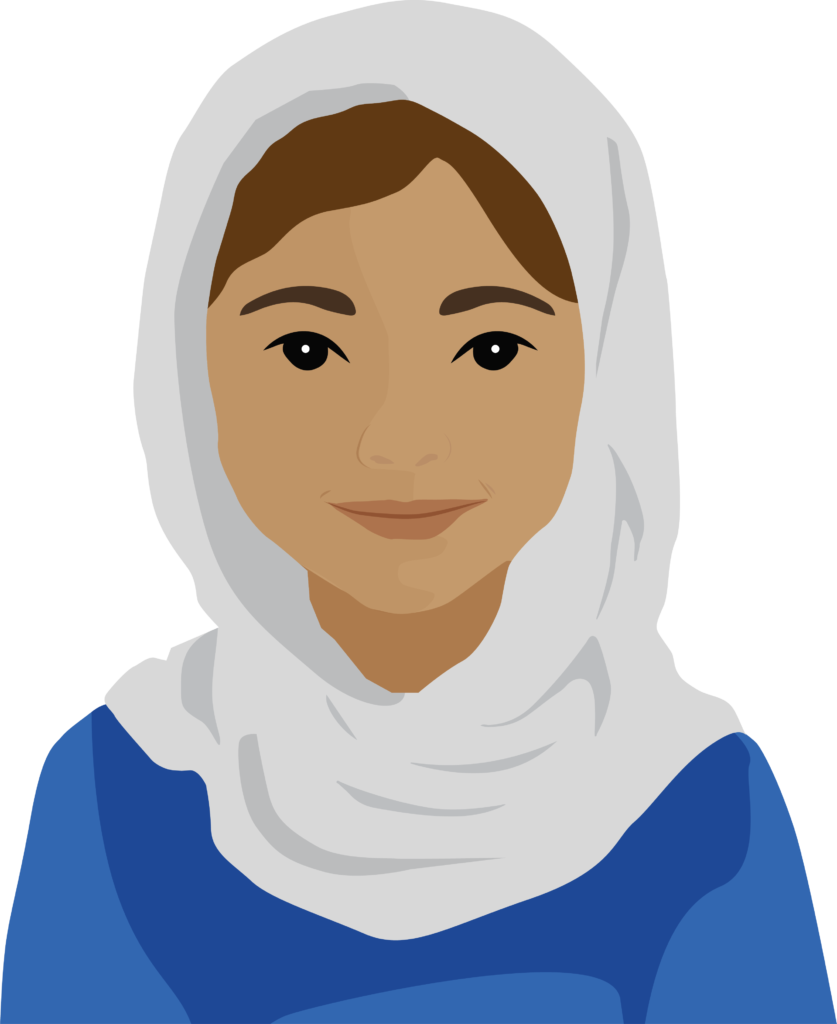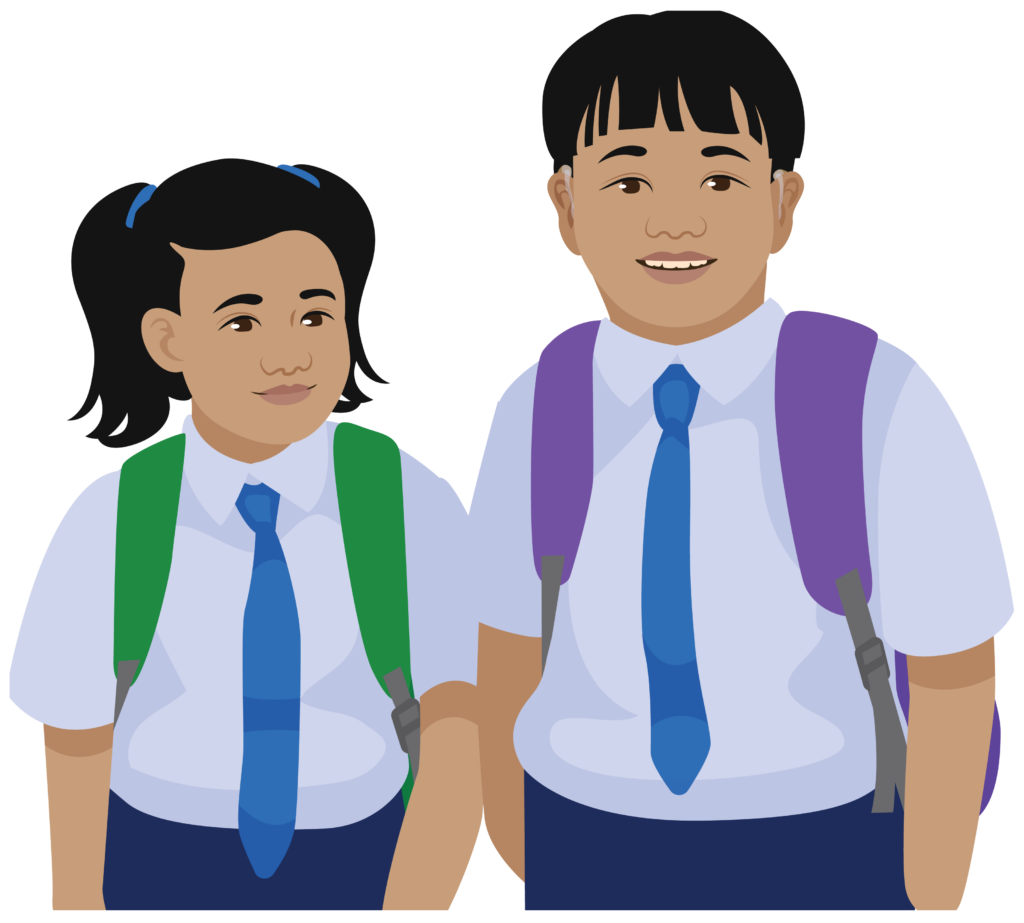À l'issue de l'entretien d'évaluation, établissez un plan avec l'enfant et la personne qui s'occupe de lui. Ce plan peut comprendre les éléments suivants :
- Surveiller l'audition
- Orienter la personne vers un spécialiste
- Fournir une aide auditive
- Expliquer à l'enfant et à la personne qui s'occupe de lui comment utiliser l'aide auditive en toute sécurité
- Poser un rendez-vous de suivi

Surveillance de l'audition
Vous devez surveiller les enfants dont l'audition se situe dans la fourchette normale et prévoir un suivi dans un an pour refaire un test de l'audition.
Encouragez l'enfant et la personne qui s'occupe de lui à revenir plus tôt si l'audition a changé.
Vous souvenez-vous d'Anju ?

Le résultat du test de l'audition d'Anju se situe dans la plage normale pour les deux oreilles.
L'agente de santé explique que quelques gestes simples aideront Anju à préserver la santé de ses oreilles :
- Éviter d'insérer quoi que ce soit dans les oreilles.
- Éviter de se baigner dans des eaux sales.
- Utiliser des bouchons d'oreille dans les environnements bruyants.
L'agente de santé demande aux parents de revenir dans un an avec Anju pour refaire un test de l'audition dans le cadre du suivi. Elle explique qu'ils doivent revenir plus tôt si Anju a mal à l'oreille, si elle a des écoulements ou si son audition a changé.
Orientation
Certains enfants ont besoin d'une évaluation approfondie par un spécialiste de l'oreille et de l'audition.
Ne fournissez pas d'aide auditive aux personnes suivantes :
- Enfants présentant une perte d'audition sévère à profonde
- Enfants présentant une perte d'audition asymétrique - écart de plus de 15 dB entre l'oreille droite et l'oreille gauche
Avec l'accord de la personne qui s'occupe de l'enfant, orientez l'enfant vers un spécialiste de l'oreille et de l'audition.
Si vous n'avez pas entière confiance dans le résultat du test, discutez-en avec votre mentor et orientez l'enfant vers un spécialiste de l'oreille et de l'audition.
Question
Lisez les études de cas suivantes.
1. Beth a 13 ans. Le seuil d'audition moyen dans son oreille droite est de 67 dB. Le seuil d'audition moyen dans son oreille gauche est de 69 dB.
Regardez le tableau des degrés de perte d'audition.
| Degré | Moyenne | Recommandation |
| Plage d'audition normale | Moyenne inférieure à 20 dB | Adultes et enfants : une aide auditive n'est pas nécessaire. Expliquer comment préserver la santé des oreilles. Réévaluer dans un an ou plus tôt si l'enfant ou la personne qui s'occupe de lui remarque un changement de l'audition ou de l'état de santé des oreilles. |
| Perte d'audition légère | Moyenne de 20 à 34 dB | Enfants : Fournir une aide auditive. Adultes : Surveiller et réévaluer dans un an. Expliquer comment préserver la santé des oreilles. |
| Perte d'audition modérée | Moyenne de 35 à 49 dB | Adultes et enfants : Fournir une aide auditive. |
| Perte d'audition modérément sévère | Moyenne de 50 à 64 dB | Adultes et enfants : Fournir une aide auditive. |
| Perte d'audition sévère | Moyenne de 65 à 79 dB | Enfants : Orienter vers un spécialiste de l'oreille et de l'audition. Adultes : Fournir une aide auditive. |
| Perte d'audition profonde | Moyenne supérieure à 80 dB | Adultes et enfants : Orienter vers un spécialiste de l'oreille et de l'audition. |
Que faites-vous ?
Sélectionnez une réponse.
La bonne réponse est Orienter.
Beth présente une perte d'audition sévère. Avec l'accord de la personne qui s'occupe d'elle, elle doit être orientée vers un spécialiste de l'oreille et de l'audition en vue d'une évaluation approfondie.
2. Jampa a 11 ans. Le seuil d'audition moyen dans son oreille droite est de 23 dB. Le seuil d'audition moyen dans son oreille gauche est de 55 dB.
Que faites-vous ?
Sélectionnez une réponse.
La bonne réponse est Orienter.
Le seuil d'audition de Jampa présente un écart de plus de 15 dB entre son oreille droite et son oreille gauche. Avec l'accord de la personne qui s'occupe de lui, il doit être orienté vers un spécialiste de l'oreille et de l'audition en vue d'une évaluation approfondie.
Consentement
Une aide auditive peut être indiquée pour certains enfants.
Expliquez les bénéfices potentiels des aides auditives et offrez à l'enfant l'opportunité d'en essayer avant de prendre une décision.
Si l'enfant ou la personne qui s'occupe de lui préfère ne pas recevoir d'aide auditive, encouragez-le à revenir vous voir à tout moment s'il change d'avis.
Si l'enfant et la personne qui s'occupe de lui ont donné leur accord pour qu'une aide auditive leur soit fournie, ajoutez-le dans les notes.
Fourniture d'une aide auditive
Dans un premier temps, sélectionnez un type d'aide auditive programmable parmi les options disponibles.
Notez les détails sur le formulaire, notamment :
- Prothèse auditive
- Embout
- Pile
Conseil
Notez les numéros de série figurant sur l'emballage et dans le manuel de l'utilisateur. Le numéro de série d'une aide auditive programmable peut être enregistré dans le logiciel de programmation lorsque l'aide auditive est connectée.
Explication du mode d'utilisation
Pour que l'enfant tire le meilleur parti de son aide auditive, il est important d'expliquer les point suivants à l'enfant et à la personne qui s'occupe de lui :
- les bénéfices d'une aide auditive
- comment utiliser et entretenir une aide auditive
- comment vérifier le niveau de charge de la pile et quand la remplacer
- comment améliorer la compréhension des mots
Instruction
Pour en savoir plus sur l'utilisation d'une aide auditive, suivez la quatrième leçon.
Suivi
Les enfants ont besoin de temps pour s'adapter à l'utilisation d'une aide auditive. Il peut être utile de leur fournir des conseils pour résoudre des problèmes simples.
Il est important d'effectuer un suivi en personne avec l'enfant et la personne qui s'occupe de lui dans les deux semaines qui suivent la pose de l'aide auditive pour vérifier comment l'enfant s'y habitue.
Instruction
La cinquième leçon fournit des informations détaillées sur le suivi des enfants équipés d'une aide auditive.
Instruction
Afin de tester vos connaissances, élaborez un plan pour Basir.
Question

Vous souvenez-vous de Basir ?
Basir a six ans. Il va à l'école avec sa sœur Siti, âgée de cinq ans. À l'issue d'un dépistage scolaire, Basir a été orienté vers un service de test de l'audition qui a révélé une perte d'audition. Les résultats montrent que Basir a un seuil d'audition moyen de 53,75 dB dans l'oreille droite et de 56,25 dB dans l'oreille gauche.
Regardez le tableau des degrés de perte d'audition.
| Degré | Moyenne | Recommandation |
| Plage d'audition normale | Moyenne inférieure à 20 dB | Adultes et enfants : une aide auditive n'est pas nécessaire. Expliquer comment préserver la santé des oreilles. Réévaluer dans un an ou plus tôt si l'enfant ou la personne qui s'occupe de lui remarque un changement de l'audition ou de l'état de santé des oreilles. |
| Perte d'audition légère | Moyenne de 20 à 34 dB | Enfants : Fournir une aide auditive. Adultes : Surveiller et réévaluer dans un an. Expliquer comment préserver la santé des oreilles. |
| Perte d'audition modérée | Moyenne de 35 à 49 dB | Adultes et enfants : Fournir une aide auditive. |
| Perte d'audition modérément sévère | Moyenne de 50 à 64 dB | Adultes et enfants : Fournir une aide auditive. |
| Perte d'audition sévère | Moyenne de 65 à 79 dB | Enfants : Orienter vers un spécialiste de l'oreille et de l'audition. Adultes : Fournir une aide auditive. |
| Perte d'audition profonde | Moyenne supérieure à 80 dB | Adultes et enfants : Orienter vers un spécialiste de l'oreille et de l'audition. |
Que recommanderiez-vous dans le cas de Basir ?
Sélectionnez une réponse.
La bonne réponse est Fourniture d'une aide auditive.
Basir présente une perte d'audition modérément sévère dans les deux oreilles. Il est recommandé de lui fournir une aide auditive.